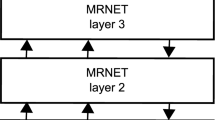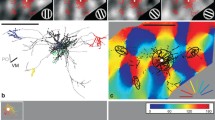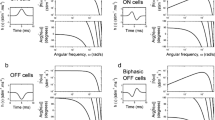Abstract
Heiligenberg (1987) recently proposed a model to explain how the representation of a stimulus variable through an ordered array of broadly tuned receptors could allow a degree of stimulus resolution greatly exceeding the resolution of the individual receptors which make up the array. In his model, this “hyperacuity” is achieved by connecting the receptors to a higher level pool interneuron according to a linear synaptic weighting function. We have extended this model to the general case of arbitrary polynomial synaptic weighting functions, and showed that the response function of this higher level interneuron is a polynomial of the same order as the weighting function. We also proved that Hermite polynomials are eigen-functions of the system. Further, by allowing multiple interneurons in the higher level pool, each of which is connected to the receptors according to a different orthogonal weighting function, we demonstrated that extended stimulus functions can be represented with enhanced precision, rather than just the value of individual point stimuli. Finally, we suggest a solution to the problem of “edge effect” errors arising near the ends of finite receptor arrays.
Similar content being viewed by others
References
Baldi P, Heiligenberg W (1988) How sensory maps could enhance resolution through ordered arrangements of broadly tuned receivers. Biol Cybern 59:313–318
Blasdel GG, Fitzpatrick D (1984) Physiological organization of layer 4 in macaque striate cortex. J Neurosci 4:880–895
Heiligenberg W (1987) Central processing of the sensory information in electric fish. J Comp Physiol A161:621–631
Jacobs GA, Miller JP (1988) Analysis of synaptic integration using the laser photo-inactivation technique. Experientia 44:361–462
Jacobs GA, Miller JP, Murphey RK (1986) Cellular mechanisms underlying directional sensitivity of an identical sensory interneuron. J Neurosci 6:2298–2311
Knudsen EI, du Lac S, Esterly SD (1987) Computational maps in the brain. Ann Rev Neurosci 10:41–65
Konishi M (1986) Centrally synthesized maps of sensory space. Trends Neurosci 9:163–168
Sansone G, Diamond AH, Hille, E (1959) Orthogonal functions. Interscience, New York
Westheimer G (1975) Visual acuity and hyperacuity. Invest Ophthalmol Vis Sci 14:570–572
Westheimer G, McKee SP (1977) Spatial configurations for visual hyperacuity. Vision Res 17:941–947
Author information
Authors and Affiliations
Rights and permissions
About this article
Cite this article
Zhang, J., Miller, J.P. A mathematical model for resolution enhancement in layered sensory systems. Biol. Cybern. 64, 357–364 (1991). https://doi.org/10.1007/BF00224702
Received:
Accepted:
Issue Date:
DOI: https://doi.org/10.1007/BF00224702




